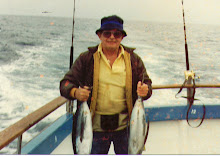First off, about four years ago the city Alma installed a three mile long cement walkway near the shore of Harlan County Reservoir. It takes a person along grassy areas at its beginning in town, travels through two or three wooded areas, bisects a couple of small meadows and ultimately terminates at the Methodist Cove boat launching ramp right on the lake. Eva and I normally start at dawn and walk to the halfway point where there is a convenient bench. There we sit while I wait for my arthritic left hip to quit screaming at me and I take in a terrific vista of the lake itself. When my aging, decrepitizing (is there such a word?) body has recovered, we march back to our starting point. My pedometer has confirmed that the round rip march is a three mile trek, which we accomplish in just about one hour. Ours is not a leisurely stroll, it's a fairly aerobic pace and works well for both of us.

Here is where we start. The manicured area greets us at the beginning and welcomes us back when we have completed our route. It was here, a couple of months ago, that we saw a momma opossum trudging across the grass with five or six of her little ones clinging to her back.

Fallen leaves in the wooded areas confirm that the fall season is now in charge. While most of the trees still have their leaves, enough are on the ground to "leave" no doubt as to the departure of summer.

Normally, the morning sun is just starting its climb into the sky and not every area is fully lighted. The partial sunlight creates some striking views of the wooded areas. The grasses in the foreground have been throughly pushed flat by groups of deer, who use this small meadow to relax or sleep. With the tall corn crops now harvested, the deer, who often spend their days hidden in the corn fields, now come to the wooded portions of this protected area. Deer hunting season begins November 1, and they seem to sense that the law prohibits hunting on this side of the lake. We see as many as eight to ten deer each morning as they take flight at the sight of us.

Small creeks, or rills (I've always wanted to use that word), find their way down to the lake. We've seen wild turkeys, pheasants and, of course, deer drinking from this creek. Where there is abundant water, the grasses are still green, but that won't last long. Winter is seriously approaching.

This is our view from the bench at our halfway point. The lake is almost nine miles long and there are dozens of places to view it, but this is my favorite. The sun hasn't reached here yet, but it is still a remarkable view. Normally, I fish on the far side of the lake at a place called Cedar Point. With fall here, it's time for several species of fish to start feeding. I can't wait.

I understand why professional photographers love to play with different lighting. Here the rising sun creates a scene I simply can't pass up.
Here are some more scenes from the walk:





A Dixie Chicks song includes the lines: " I wanna look at the horizon and not see a building standing tall... I wanna be the only one for miles and miles...."
I find that concept appealing, and the walk is the place where it comes to life for me.
It's a bonus I didn't know existed when I decided to move here. It helps me feel blessed every day and I fully appreciate that every day is, indeed, a gift.



